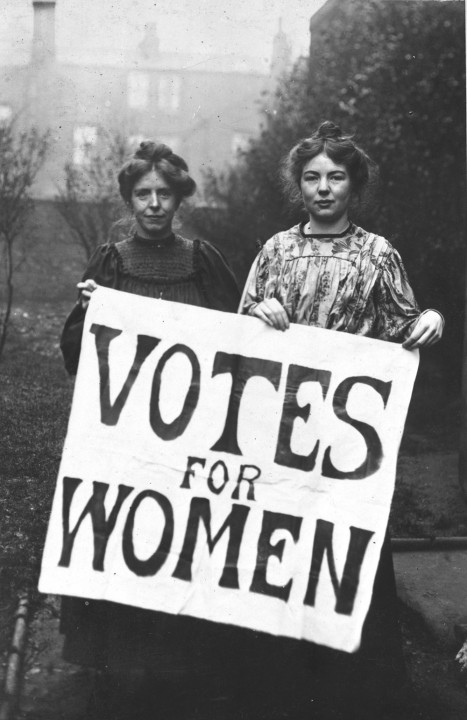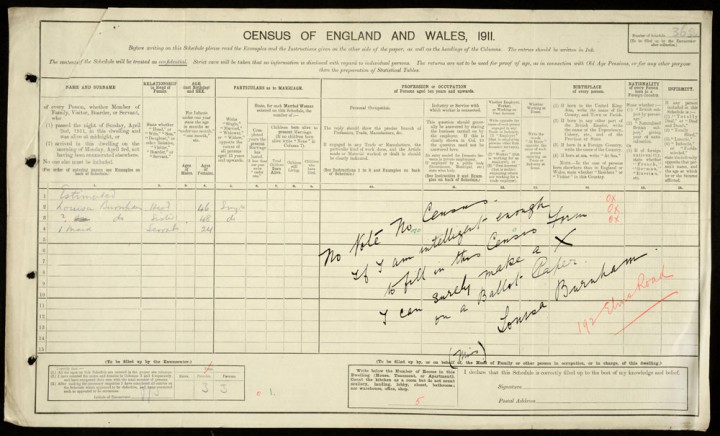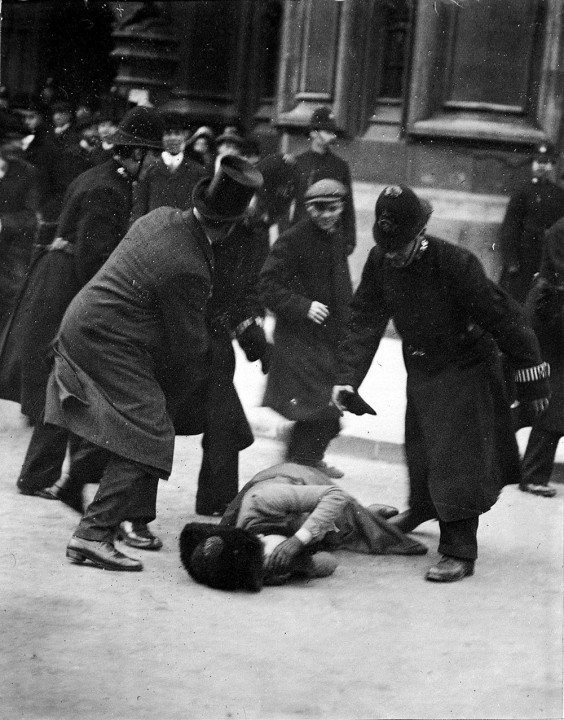How to look for records of... Women’s suffrage
How can I view the records covered in this guide?
How many are online?
- Some
1. Why use this guide?
This guide will help you to find records of the women’s suffrage movement and of the women and men who campaigned for the cause in the early part of the 20th century.
Our collection reflects the interests of the government and offers an insight into how it responded to civil disobedience and changes to public opinion.
Many other records of suffrage organisations and activities will be held at local or specialist archives some of which are mentioned in section 6.
2. Overview of our collection
2.1 What you might find
The National Archives holds records of central government and the major courts of law. Our collection is a rich source of information about the government’s response to militant activities and civil disobedience such as destruction of property, tax evasion and census boycotts.
Peaceful protest was of less interest to the government, although large demonstrations drew the attention of the authorities even where they were orderly and peaceful. In general, however, you will find more records relating to militant activity.

Suffragettes Annie Kenny and Christabel Pankhurst 1906 (COPY 1/494)
2.2 What period do the records cover?
Records are most plentiful for the period from 1905 up to the start of the First World War when many suffrage organisations suspended their campaigns. However, records from other years can also be found; for example where organisations such as the Women’s Freedom League continued to lobby the government on issues even after the start of the war.
2.3 What regions do the records cover?
Our records cover the whole of England and Wales, but the only police records we hold are from the Metropolitan Police force. Records of other police forces are held in local archives
3. What can I view online?
3.1 Suffragette collection
Some of the online records mentioned below have been brought together by Findmypast (£) into their ‘Suffragette Collection’. It includes records of disturbances, arrests and treatment of women in prison.
For more information about what is included look for the section ‘Learn more about these records’ on the Findmypast Suffragette collection browse page (£).
3.2 Cabinet papers
The Cabinet deals with the major issues of the day and the Government’s overall strategy. For more information about the Cabinet, including how to find records from before 1916, see our research guide Cabinet and its committees.
3.3 Census 1911
Search the 1911 census for records of suffrage campaigners and supporters. The census is available on Ancestry (£) and Findmypast (£).
Some suffrage supporters refused to participate in the 1911 census on the grounds that if they were not treated as citizens with a voice, they would not be counted on the census. Others made protest statements on the census forms and some enumerators made comments of their own.

Suffragette Louisa Burnham spoils her entry in the Census 1911 (RG 14/2277/1)
Use the ‘keyword’ field on Ancestry (£) or the ‘occupation’ field on Findmypast (£) to search for entries where activists used their entry to show their support for the suffrage movement.
Our experience is that searching the census on Ancestry produces more results if you are looking for random comments entered by suffragettes and enumerators. However, if you find better results using Findmypast (£) please let us know.
Try searching the census using:
- the names or addresses of known suffrage supporters
- ‘anonymous’ in the name field
- phrases such as ‘no vote no census’ in the keyword field
- wildcard searches in the occupation or keyword field. A search in Ancestry (£) using the wildcard ‘suffrage*’ finds numerous results.
3.4 Home Office amnesty of August 1914 and suffragette arrest records
Search or browse the index of suffragettes arrested between 1906 and 1914 (HO 45/24665) on Ancestry (£).
At the outbreak of the First World War many suffrage groups suspended action, and in response the Government granted an amnesty to suffrage prisoners. In order to implement the amnesty, the Home Office compiled an index of all suffrage campaigners arrested from 1906 to 1914.
This index is the best way to look for individual campaigners whose activity put them on the wrong side of the law. It also illustrates the variety of organisations and individuals prepared to take extreme action in the suffrage cause.
Each entry includes a reference to the original documents (not available online) relating to that person’s arrest and conviction. Where these documents have survived, you can find them by searching Discovery, our catalogue, using HO followed by the reference number.

Entry for Irene Miller in the index to suffragettes arrested (HO 45/24665)
For example, the index entry for Irene Miller, arrested at Westminster on 24 October 1906 for knocking on the door of 10 Downing Street, shows the reference number 145641 in the right hand column.
Search Discovery using HO followed by the reference number 145641. This finds the record HO 144/837/145641 which details complaints of treatment in prison by suffragettes. To see these records you will need to visit us, order copies or pay for research to be done on your behalf.
3.5 Parliamentary Archives
Search the catalogue of the Parliamentary Archives for records relating to women’s suffrage. Bills in favour of women and the vote were presented on an almost annual basis from 1870 onwards.
3.6 Parliamentary proceedings in Hansard
Hansard is an edited record of what was said in Parliament. It also includes records of votes and written ministerial statements. The report is published daily covering the preceding day, and is followed by a bound final version.
Search the official reports of proceedings in the House of Commons and the House of Lords from the late 19th and early 20th centuries for reference to the women’s suffrage movement.
3.7 Women in The National Archives
Consult ‘Women in The National Archives’ by Martin Pugh, in the Adam Matthew collection (£). This is available free of charge at The National Archives or in libraries with the relevant institutional subscription.
This lists women’s studies resources in The National Archives together with original documents relating to suffrage in Britain, the Empire and colonial territories.
3.8 Newspaper reports
Search the British Newspaper Archive (£) and the Times Digital Archive (institutional subscription required) for reports in local and national papers relating to the suffrage movement.
3.9 Archival film footage
The National Archives has some film footage related to the suffragette movement available online.
- Suffragette pageant in London 1908
- News footage of buildings destroyed by suffragette protest
- Emily Davison killed at the Derby
Other film is available on the BFI National Archive website.
4. How to search our catalogue for records
4.1 General tips
When you search Discovery, our catalogue, you can apply filters such as dates, record series references and department codes, before your search by using the advanced search option.
Alternatively, you can apply filters after your search using the options on the search results page.
For more advice on searching effectively see Discovery help.
4.2 Keywords
Search Discovery, our catalogue, using keywords such as
- names of known activists (only used rarely in record descriptions so will often not get results)
- suffragist, suffragette or ‘suffrag*’ (a wildcard search)
- names of suffrage organisations (see section 4.5 for examples)
- names of offences committed such as window smashing, disturbances, demonstration
- combinations of the above
Militant suffrage supporters were known as suffragettes and non-militant campaigners were known as suffragists. Often, the government used the terms interchangeably or not at all.
If you find other keywords that bring good results please contact us to let us know.
4.3 Government department codes
Certain government departments were involved in managing the response to the suffrage movement. You can search within records created by these departments by using the associated department code reference in Discovery advanced search.
Use this code in the ‘search for or within references’ fields, along with a keyword and dates (if you wish) in the appropriate fields.
Some examples of department code references you can try are shown below along with the sort of subjects you might find covered by these departments:
- Treasury (T) – tax resistance as a form of protest
- Home Office (HO) – offences and complaints of treatment of suffragettes by police and in prison
- Metropolitan police (MEPO) – arrests of suffragettes
- Prison Commission (PCOM) – prison treatment of suffragettes
- Ministry of Transport (MT) – impact of the suffrage movement on transport
- Cabinet Office (CAB) – discussions about the suffrage movement at the top level of government (see section 3.1)
5. Suffrage organisations, protest action and legislation
5.1 Suffrage organisations
Numerous organisations pressured the government to give women the vote. Parliament.uk has a useful timeline that includes the establishment of many suffrage groups. Search Discovery, our catalogue, using the names of suffrage organisations and the people involved in them to find relevant records. Some of the key organisations are listed below:
- 1866 Women’s Suffrage Committee formed by Barbara Bodichon
- 1867 National Society for Women’s Suffrage formed by Lydia Becker
- 1897 National Union of Women’s Suffrage Societies formed by Millicent Fawcett
- 1903 Women’s Social and Political Union formed by the Pankhursts
- 1907 Women’s Freedom League (WFL) formed by Teresa Billington-Greig and Charlotte Despard
- 1908 Women’s National Anti-Suffrage League (WASL) formed by Mary Ward (Mrs Humphrey Ward)
- 1909 Women’s Tax Resistance League (WTRL) formed by Dora Montefiore
5.2 Protest action

Believed to be suffragette Ernestine Mills at Black Friday demonstration November 1910 (Copy 1/551)
Suffragettes favoured more militant action than suffragists. The most active organisation was the Women’s Social and Political Union led by Emmeline and Christabel Pankhurst.
Action to draw attention to the cause took place across the UK. It included refusing to complete the 1911 census, protest rallies and marches and destruction of property. Many suffragettes were prosecuted and some were imprisoned.
Use the advanced search option in Discovery, our catalogue to search for records relating to arrests, prosecution and treatment in prison. Some of the key protest actions are shown below. The names of the protests and the dates they took place can be useful in searching for relevant records.
Search Discovery using keywords along with department code references MEPO for the Metropolitan Police, PCOM for the Prison Commission and HO for the Home Office. Use these department codes in the ‘search for or within references’ fields, along with a keyword and dates (if you wish) in the appropriate fields.
- 1905 First imprisonment of a suffragette, Christabel Pankhurst
- 1907 First large procession, known as the Mud March, organised by the National Union of Women’s Suffrage Societies
- 1908 (June) Seven processions march through London (see this video clip)
- 1908 (October) The ‘rush on Parliament’
- 1908 (October) Suffragette banner unfurled from the ladies’ gallery in the Houses of Parliament
- 1909 (July) First hunger strike action, by Marion Wallace
- 1910 (November) Black Friday demonstrations outside Houses of Parliament.
- 1912 (March) Women’s Social and Political Union window-smashing campaign in the West End of London leading to 220 arrests
- 1913 (June) Emily Davison killed by King’s horse at Epsom Derby (see this video clip)
5.3 Legislation
Try searching Discovery using the names of Acts of Parliament that relate to women’s suffrage. You could also search more generally around dates legislation was introduced to find records of events that led up to it, debates around it and reactions to it.
From as early as 1832 attempts were made to introduce legislation to give women the vote. Parliament.uk has a useful timeline of key legislation that you can use to inform your research. Some of the most useful are listed below.
- 1913 Prisoners’ Temporary Discharge for Ill-health Act – also known as ‘The Cat and Mouse Act’ (introduced in response to hunger strikes)
- 1918 Representation of the People Act (allowed some women over 30 to vote in national elections) – this represented 40% of total population of women
- 1918 The Parliament (Qualification of Women) Act allowed women to stand as MPs
6. Records in other archives
Two key collections are in the London School of Economics and Political Science (LSE) Women’s Library and the University of Manchester Library: Women’s Suffrage Movement Archives
There are numerous collections of records across the UK. Use the Find an Archive tool to look for local archives or search the Archives Hub for relevant collections.
7. Further reading
7.1 Blogs
- Keeping tabs on suffragettes: the official watch list
- Motoring towards liberation
- The Hunger games
- The working women’s struggle for the vote
- Celebrating democracy for International Archives Day
- Suffragettes in the Parliamentary Archives
7.2 Printed books and articles
Many books are available in The National Archives’ reference library. You can search the library catalogue for titles of interest.
You can also visit The National Archives’ bookshop for a range of publications on women’s suffrage.
- The March of the Women: a Revisionist Analysis of the Campaign for Women’s Suffrage 1866-1914, Martin Pugh (Oxford University Press 2002)
- The Militant Suffragette Movement in York, Kristina Cowman (Borthwick Publications, 2007)
- Sex and suffrage in Britain 1860-1914, Susan Kingsley Kent (Routledge, 1990)
- The Suffragette Movement: An Intimate Account of Persons and Ideals, E Sylvia Pankhurst (Wharton Press, 2010)
- Rise up, women!: The Militant Campaign of the Women’s Social and Political Union, 1903-1914, Andrew Rosen (Routledge, 2012)
- Separate Spheres: The Opposition to Women’s Suffrage in Britain, Brian Harrison (Routledge, 2012)
- Women and the Women’s Movement in Britain, 1914-1959, Martin Pugh (Marlowe & Co, 1995)
- Suffrage and Power: the Women’s Movement 1918-1928, Cheryl Law (I.B.Tauris, 1997)
- Vanishing for the Vote: Suffrage, Citizenship and the Battle for the Census, Jill Liddington (Manchester University Press, 2014)
- Women, Welfare and Local Politics, 1880-1920: ‘We Might be Trusted’, Steven King (Sussex Academic Press, 2006)
- Rebel Girls: Their Fight for the Vote, Jill Liddington (Virago Press, 2008)
- Sophia: Princess, Suffragette, Revolutionary, Anita Anand (Bloomsbury, 2015)
- Women’s suffrage and government control 1906-1922: papers from the Cabinet, Home Office and Metropolitan Police files in the Public Record Office (Adam Matthew Publications, 2000)
8. Other resources
8.1 Audio recordings
The National Archives has recorded podcasts available online.
8.2 Websites
- The National Archives Education pages on suffragette history
- The Parliamentary Archives women and the vote pages
- Woman and her Sphere